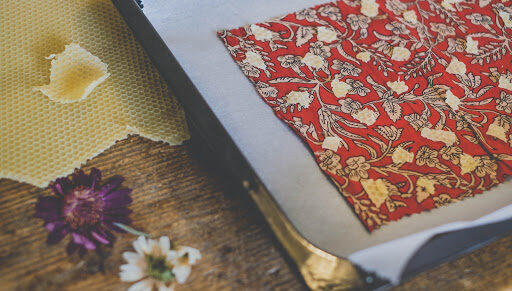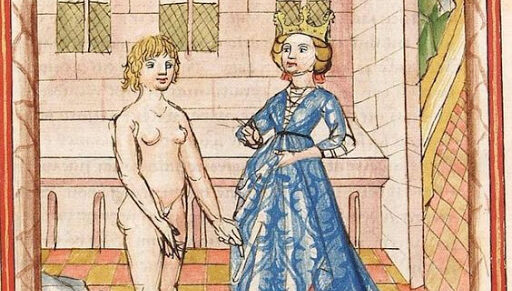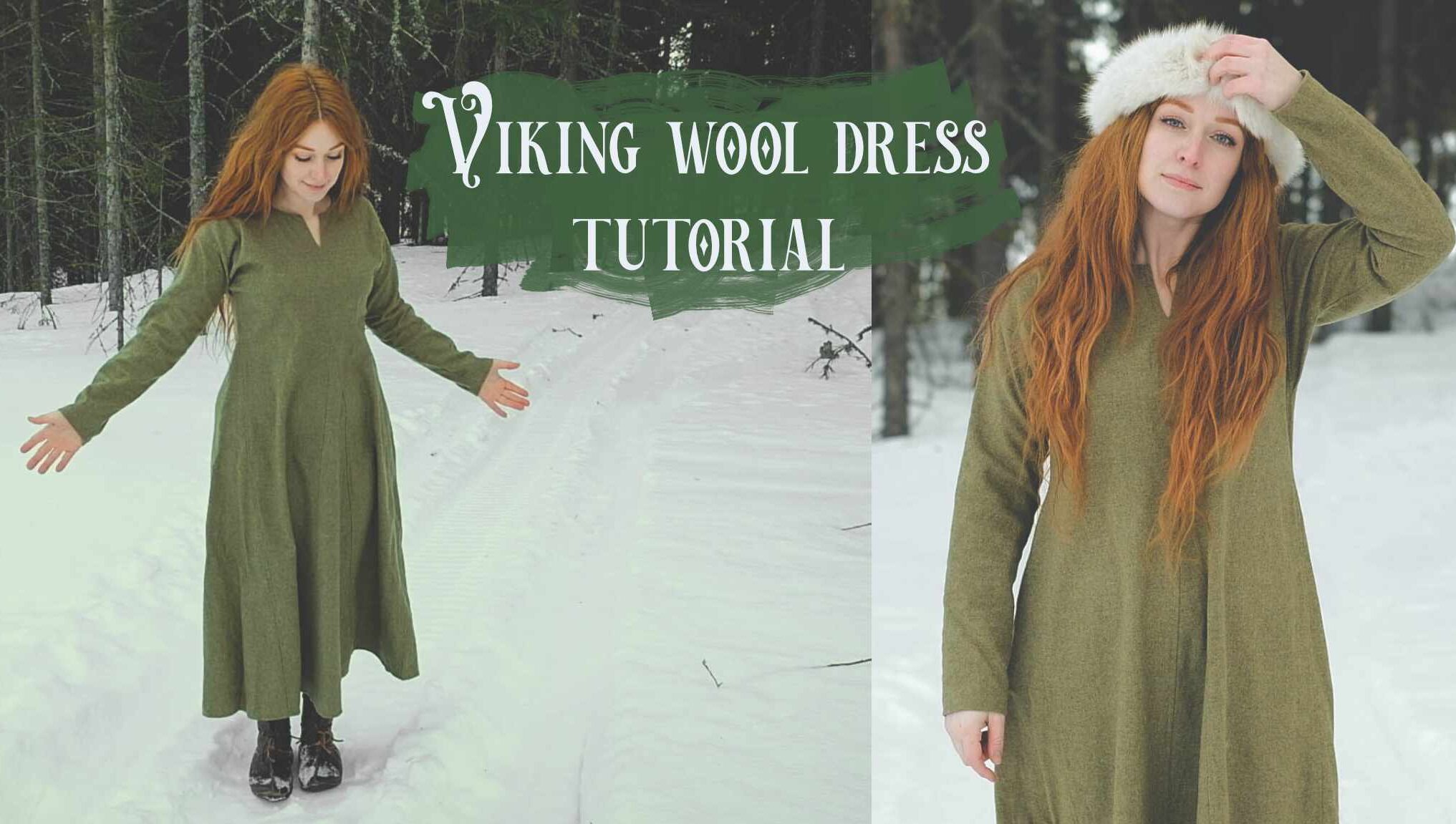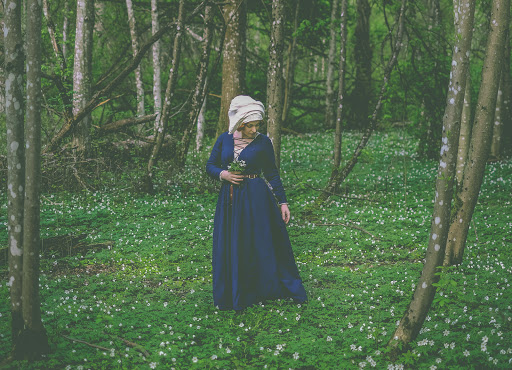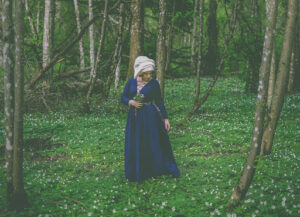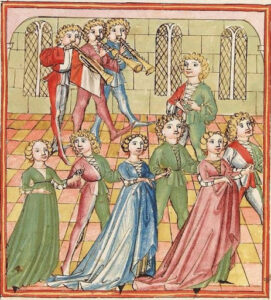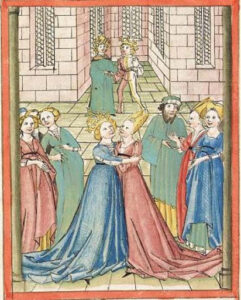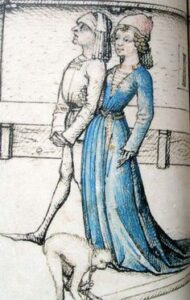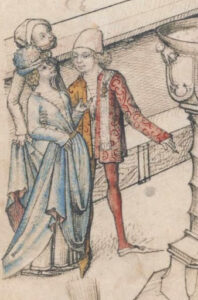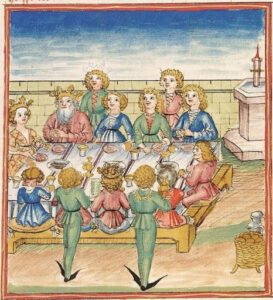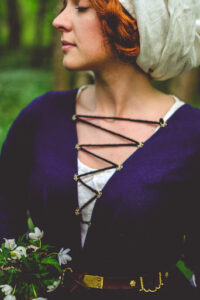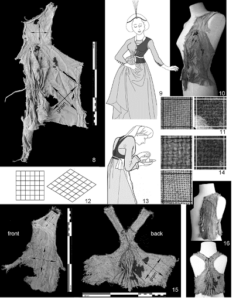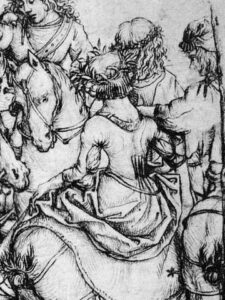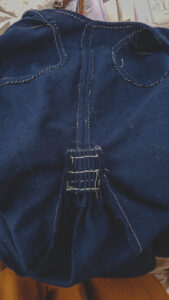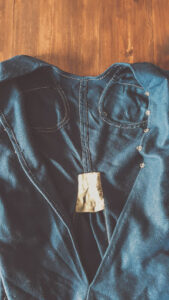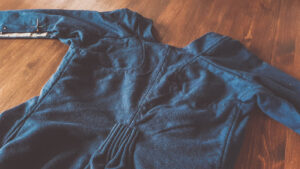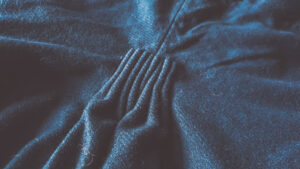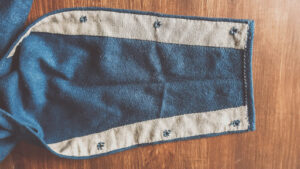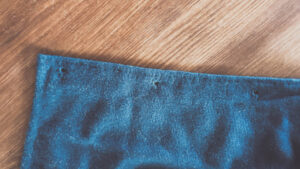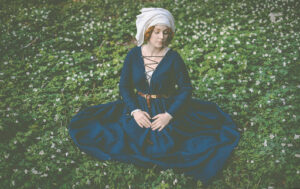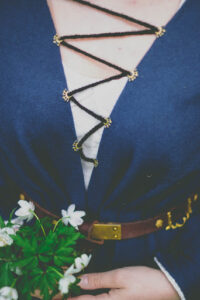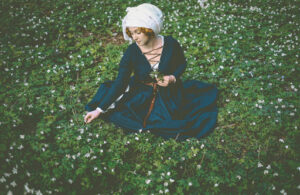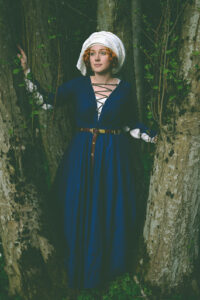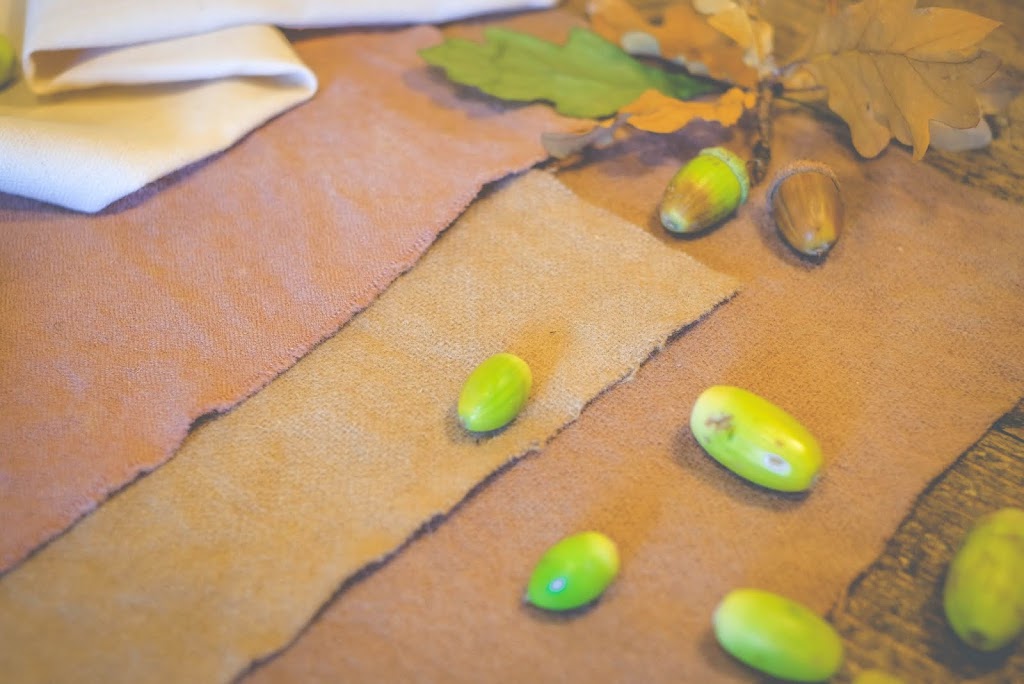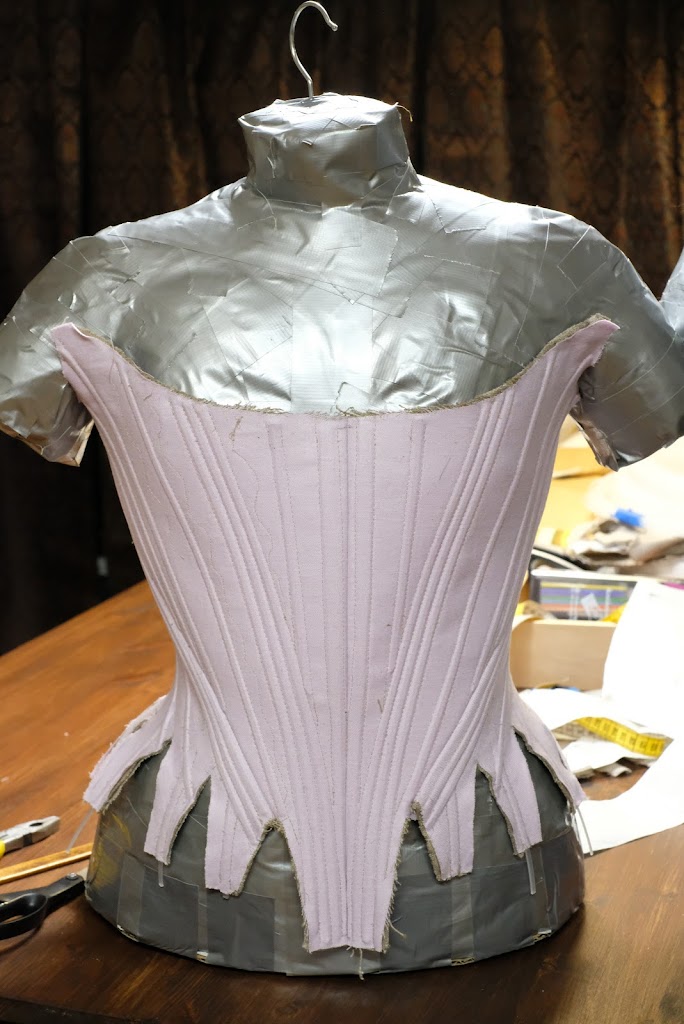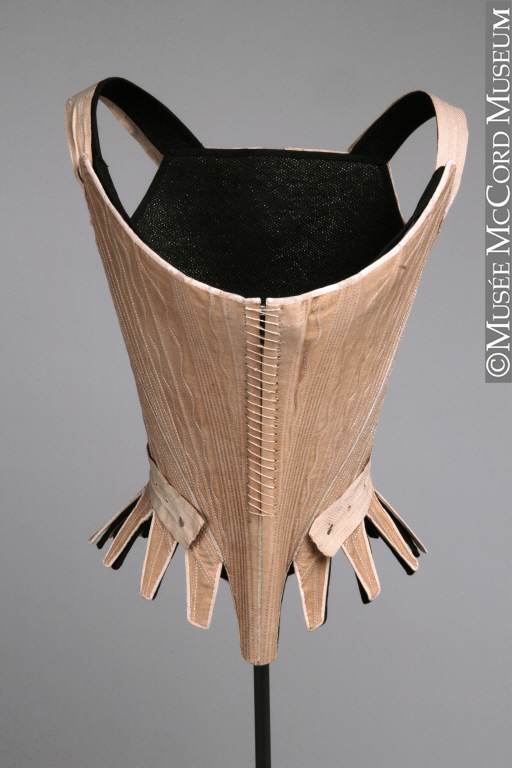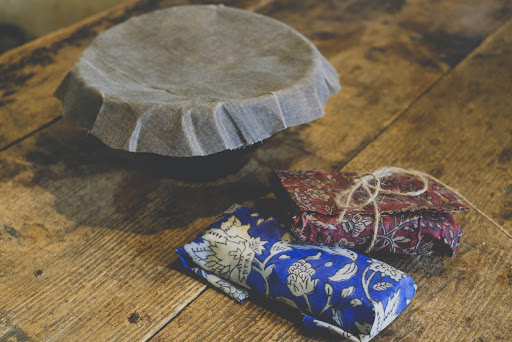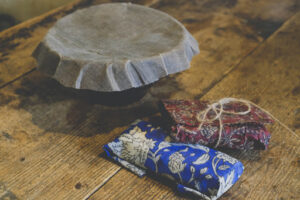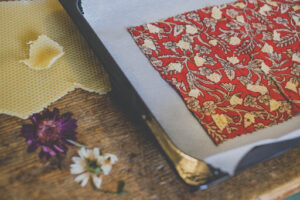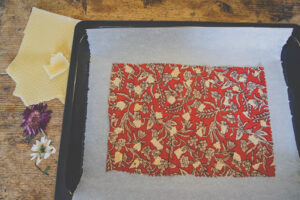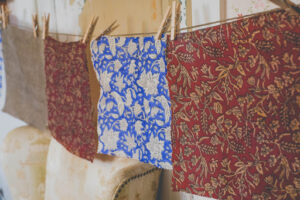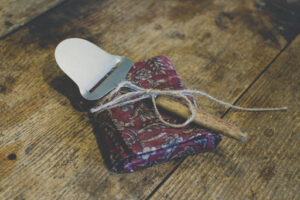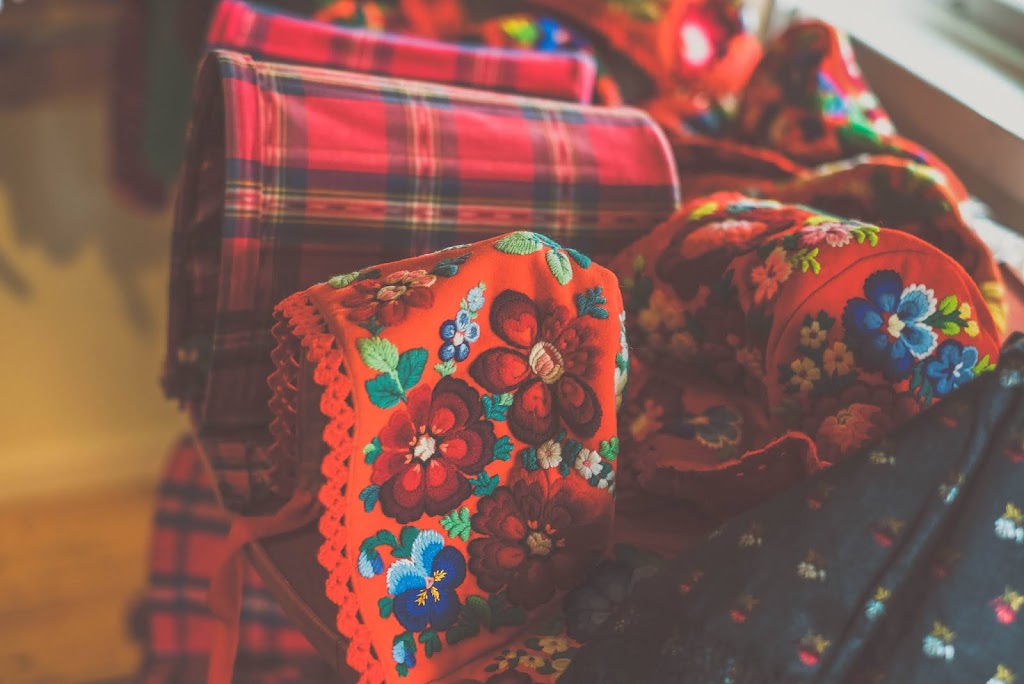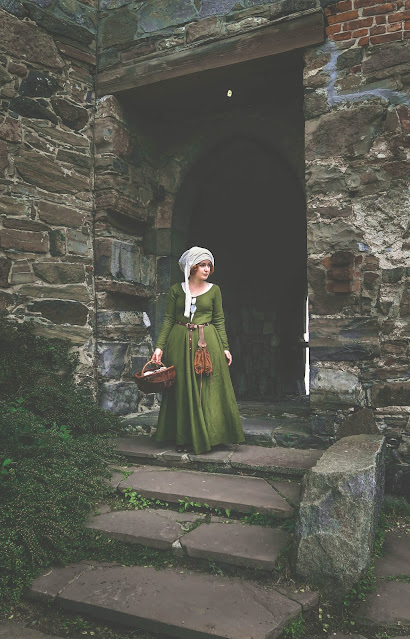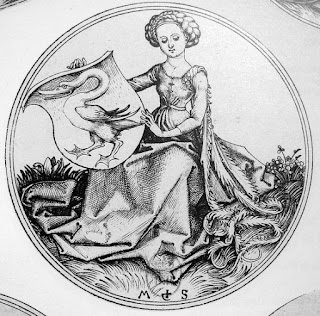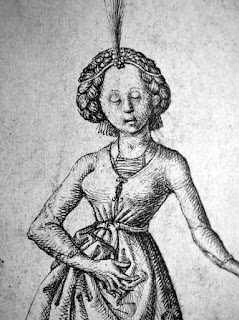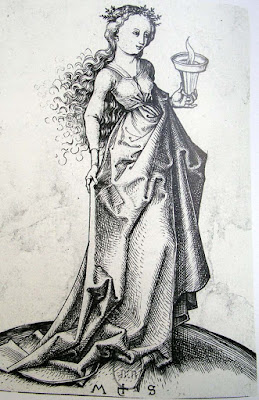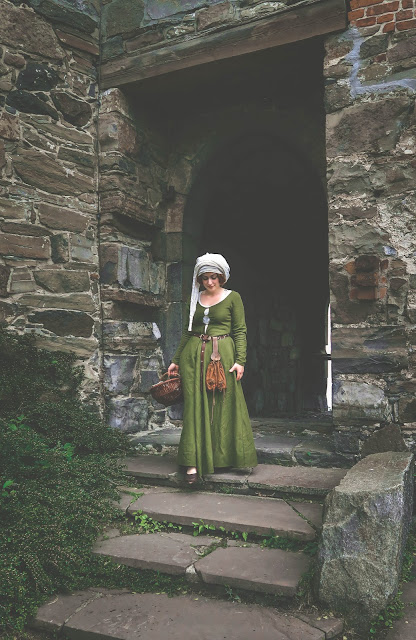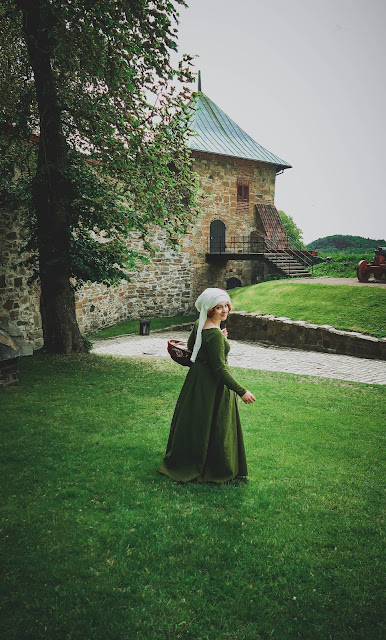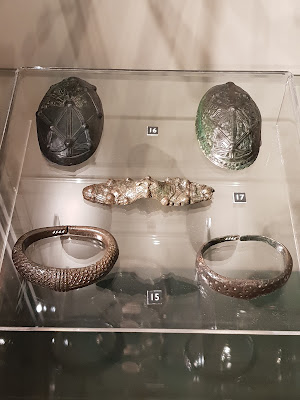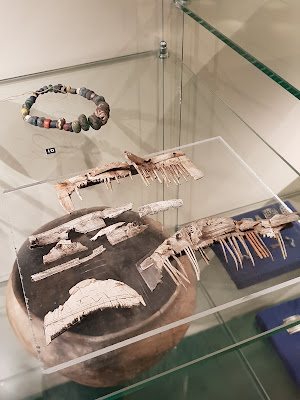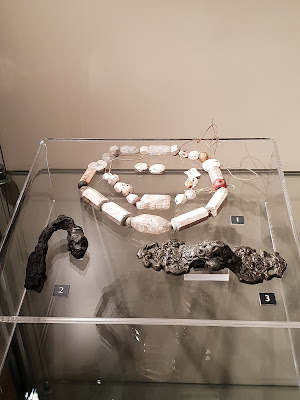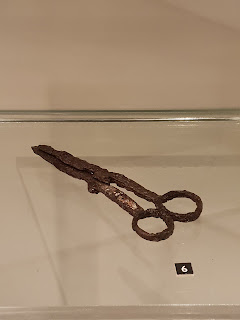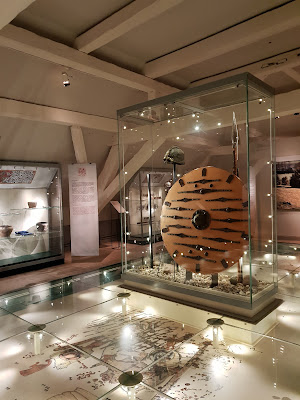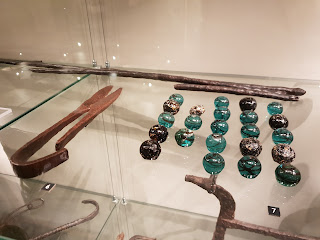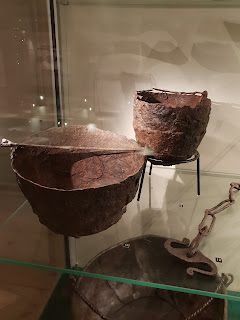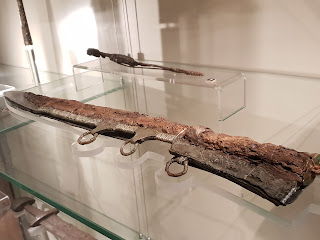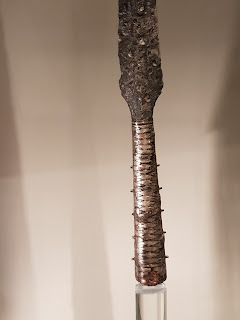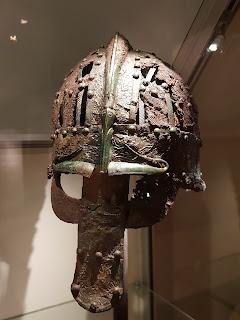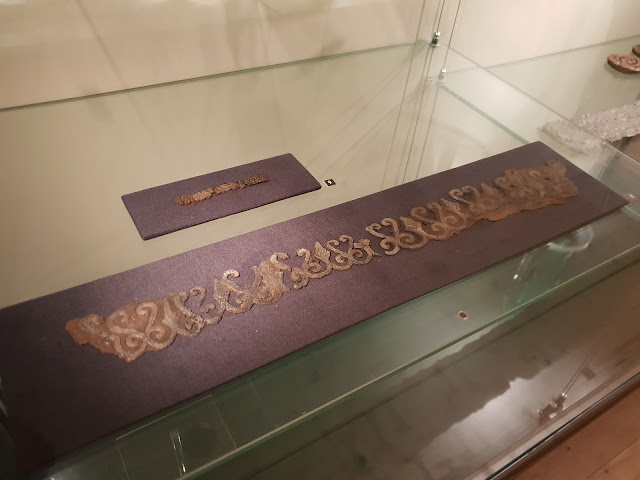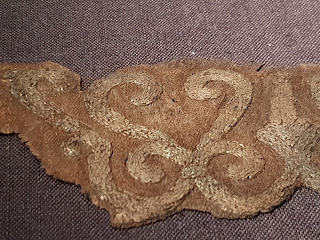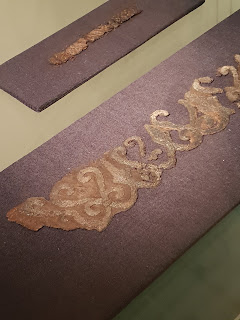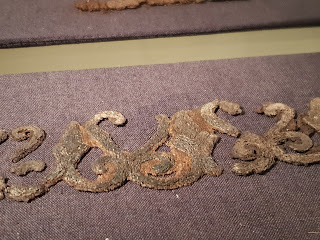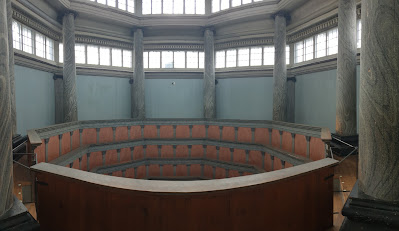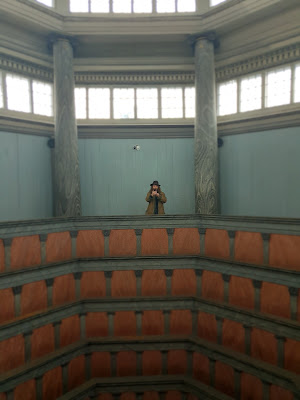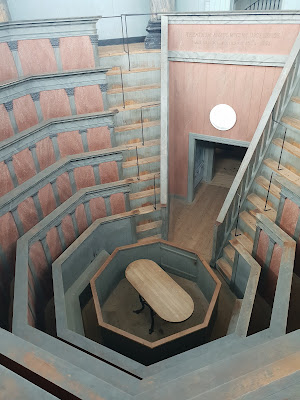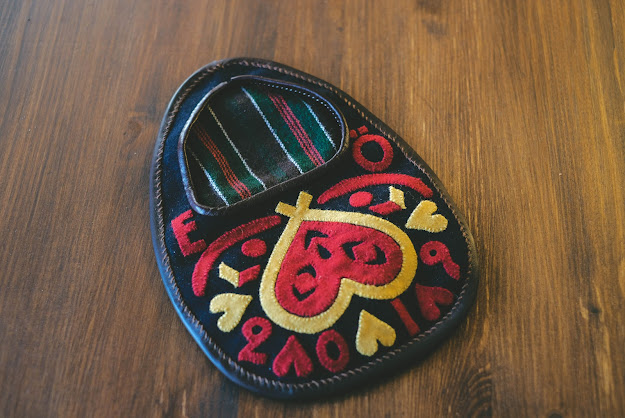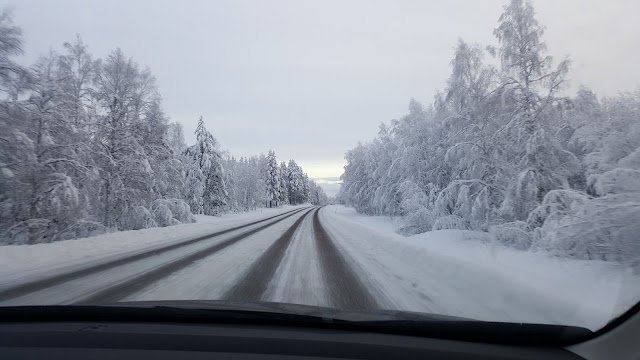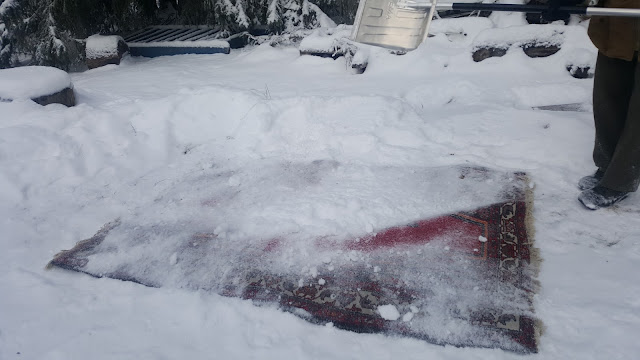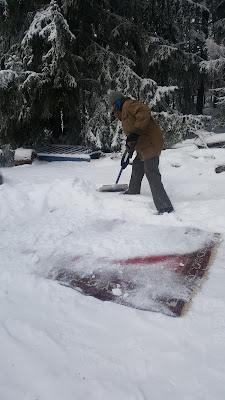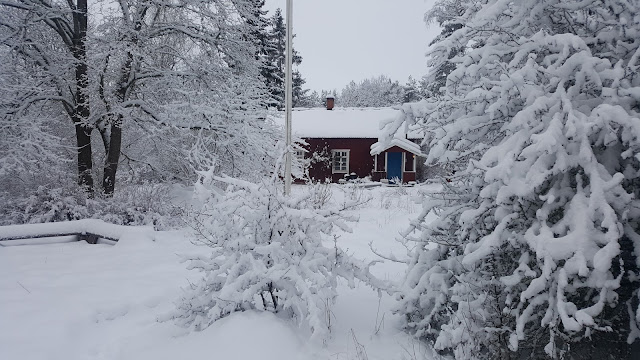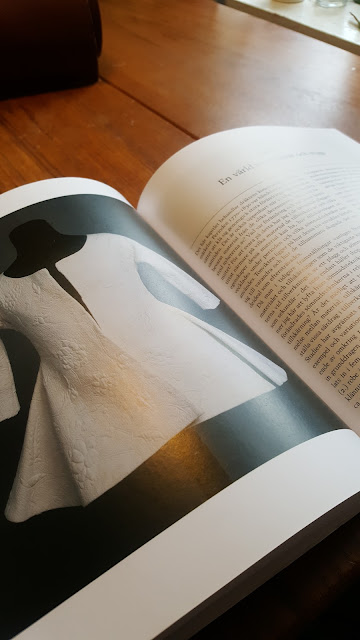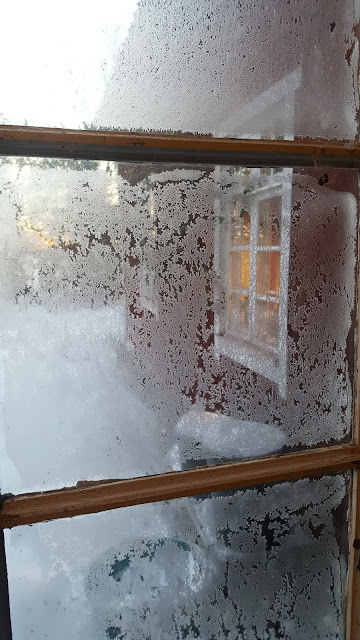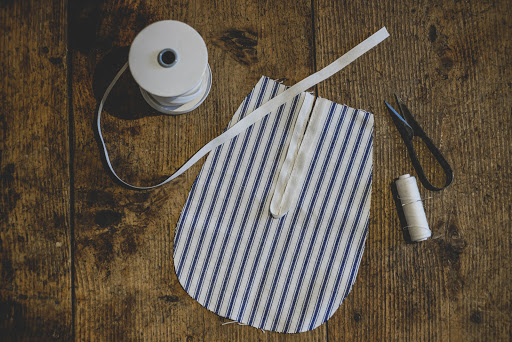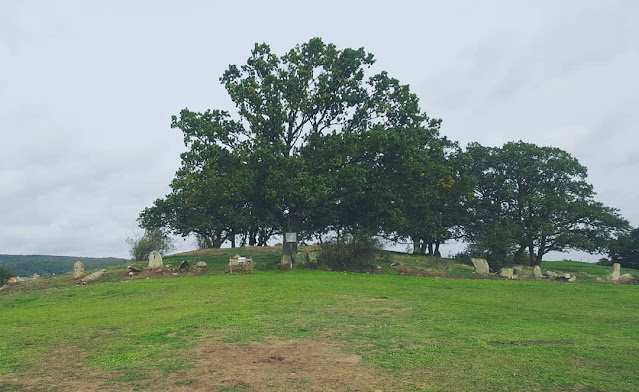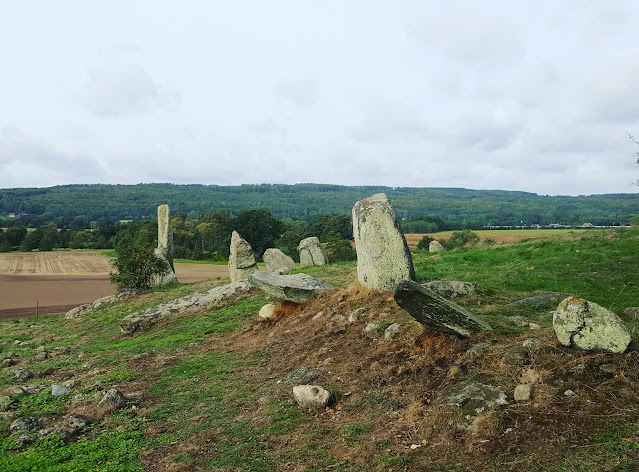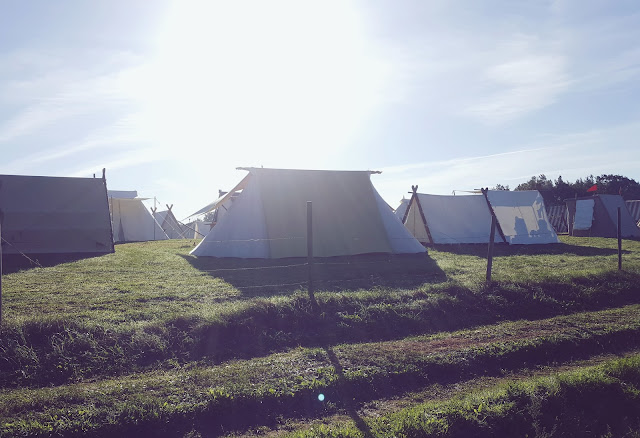-
Blue 15th century dress
Foto by Pernilla Björnsdotter edited by me.Here is a new dress that I made this winter! Im very exited about it since I
have wanted to do it for many years but alot of stuff got in the way… I love
the lacing on these gowns, it seem to have been very popular for a while since
there is so many pictures with ladies wearing this type of dress in different
colors. This dress is also german from late 15th century (yes… I know but I
like it!), mostly around 1470s. The ladies in this pictures dont have any
veils on just various braids that cross on top of the forhead. I cant get that
to look good with my wig so Im wearing a late 15th century turban instead. I
also made mine without a long skirt trail since Im working in the dress. Not
correct but its to much in the way for a working girl. I did my yellow dress
long first but had to cut it so I learnt from my mistake. If you only visit a
market or other event then defenetly go for the long skirt! 🙂Note the guys curly hair! They must have been doing alot of curling up on
fabric scraps haha!Some of the girls have ”underskirts” of some kind. I wonder if they have a
underdress or if its the painters addition. It might be a tight lacing
underdress but I have only seen the linen ones yet so I have to search more.
It is always hard to research under layers of clothing.Dont know whats happening in this picture…but look at that brocade mrr!Foto by Pernilla Björnsdotter edited by me.Foto by Pernilla Björnsdotter edited by me.The pattern
I made this dress aswell as the yellow dress with the typical plate arms that is common in this time period. They are super tricky to make and to make it even harder I made a new version since the arm has a higher slit than my yellow dress, so had to make a new pattern. Since I was in a hurry for a market as usuall I didnt have to much time to perfect the back (soo hard to do that on your self umg..!) but it will do. If I would remake it I would give it a bit more range of movement over the shoulder/arms. On to the patern: Exept for the mog boy dress there are fragments from Lengberg castle that was found not to long ago. In the picture below are pieces of lining from this kind of dress (yey!) These finding are so great since they let us know more about the construction. I like the gore solution in the back and will defenetly try this on the next one, I did a straight top since I have seen that on many pictures aswell (see picture after this one). There is probably many ways to do it.
My pattern pieces basicly look like Queen Margareta of sweden´s dress but with the plate arm back thingy and I aded gores on the sides. I made the pieces in extra wide A-shapes for the pleating in the front.I couldnt stand the tought of putting linen lining in it (cold/heat sensative) so I decided to skip lining and do a solution like this, with linen to cover the pleats and then I made a linen ”waist ribbon” that I could sew the front pleats onto. Ps: I didnt have any blue linen thread so I just took regular instead.Foto by Pernilla Björnsdotter edited by me.Here you can see the front pleats better. I sewed them into my hidden waist ribbon, to keep them in pleace.Foto by Pernilla Björnsdotter edited by me. -
Vaxcloth
Vaxcloth!Me and Alex made wax cloths this weekend, it turned out great and was very easy to make! Scroll down to see how its made.Jag och Alex gjorde vaxdukar den här helgen, det blev jätte bra och var superlätt att göra! Skrolla ner för att se hur man gör.This is gonna be the shortest tutorial ever, its so easy to make!1. Turn on the owen at 100C degrees.2. Put a piece of fabric on a baking sheet.3. Take some bees vax and pull of as small pieces you can and spread them out over the fabric. This fabric was a very thin cotton so it didnt need much. The linen fabric needed more since it was thicker and absorbed more.4. Put it all in the oven and melt for about 3-4min. You can see when its done and has melted.5. Take it out and use a baking brush to brush out uneven spots, but be fast because you have to put it up to dry almost imediatly or else it will be batches of vax.6. Let dry hanging on a chord or anything you have.Done!Det här blir en superkort instruktion eftersom det är så himla lätt att göra dessa!1. Sätt ugnen på 100 grader.2. Lägg din tygbit på en plåt med bakplåtspapper.3. Dra isär så små bitar av bivax du kan och strö ut dem över tyget. Det här bomullstyget behövde inte mkt eftersom det var så tunnt. Linnetyget krävde lite mer då det är tjockare och absorberar mer.4. Sätt in i ugnen och låt smälta i ca 3-4min. Du ser när det är klart och har smällt ut.
5. Ta ut och pensla ut lite om det är torra fläckar, men var snabb då du måste hänga uppp tyget så fort som möjligt så det inte blir klumpar.6 Låt hänga på en lina eller vad du nu har.Klart!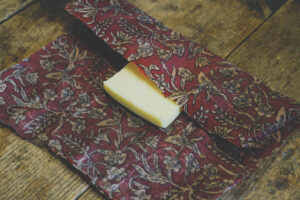 Now you can use your vax cloth to cover your cheese, a sandwitch or that bowl of left over food.If your cloth gets to soft after a while you can just melt it again with some aded vax. No more plastic wrapping!
Now you can use your vax cloth to cover your cheese, a sandwitch or that bowl of left over food.If your cloth gets to soft after a while you can just melt it again with some aded vax. No more plastic wrapping!Nu kan du använda dina vaxdukar till att slå in osten, en macka eller kanske den där skålen med rester. Inge mer plastfolie!
-
Green late 15th century dress
I dont have any pictures from when I made this dress a few year ago, maybe 2014? But I got many questions about it, since it doesnt look like a regular cotehardie so I tought I should show what I based it on. It is not a fantasy dress but a simple and nice late 15th century German dress.The fabric is a very nice and soft tabby in olive green from my shop.The pattern is my basic cotehardie pattern with S-arm, but with some extra width in the front so it would pleat in the waist. I used 2 brass button and sewed loops in wool yarn and aded 2 or 3 hooks down the waist to close the waist. -
Gustavianum museum
A little visit to Gustavianum 🙂 Gustavianum is a must if you ever visit Uppsala in Sweden. They have some vendel/viking stuff but also egyptian and all kinds of stuff related to the Uppsala university that is Swedens oldest one.Viking bling. From above; turtle brooches, clothing fibula for closing cape or coat, armrings.Glass pearl necklace and combs.Necklace and another fibula. nr2 I dont recall what it was. Maybe somebody can fill me in on that?Drinking glass that has been glued together. Pretty color!Scissor.Warior gear. Under the glas floor is a reconstruction of a boat grave.Scissor and game pieces (is that the correct word?)More game piece.Cooking potsSaxSpear. Look at that decoration!Ring claspsHelmet!My favourite item here is this embroidery from a collar from Valsgärde.Here is a bad panorama on a very cool room, its the universitys old anatomy theatre from 1663! -
Christmas 2018
-
Snow cleaning
How to clean textiles with snoSnow cleaning is perfect for cleaning stuff that is hard to clean like carpets or sheap skins.It is easier than you think, if you just have snow.1. Make sure it is cold outside, below 0. The snow should now be melting, then the dirt would just stick to your item instead of falling off with the ”dry” snow.2. Throw out your item and cover with snow.3. If your item is a carpet, scub it with a broom. You will see when you are done, then the snow will not be as brown 🙂4. Whip the carpet clean from snow and bring it in to dry.A perfect day to sit inside drinking coffe, admire the snowy landscape and reed about 18th century sewing. -
Castle ruin
-
Vinter crafts, bobbin lace
 Do you want to try something new? Try bobin lace making! Its very meditating! Its easy to find a second hand lace pillow and some patterns. You can also find free patterns online, on pinterest for example.Here you can find swedish lace patterns:
Do you want to try something new? Try bobin lace making! Its very meditating! Its easy to find a second hand lace pillow and some patterns. You can also find free patterns online, on pinterest for example.Here you can find swedish lace patterns: Trying to make this old cottage warm while doing som crafts! ^_^
Trying to make this old cottage warm while doing som crafts! ^_^ -
Rose hip soup recipe and muscroom picking
 I loove the fall! Spring and fall are my favourite seasons! I love the colors and I get to pick muchsrooms and rose hips! Homemade rose hip soup i amazing! You dont even have to take out the seeds, these i only did it on because i wanted to dry these witouth seeds.Click to see super easy and quick recipe:Rose hip soup (nyponsoppa):2 dl Rose hips5 dl water1,5 dl sugar (adjust to prefered sweetness)1 table spoon potato flourvanilla if wantedWash the rose hips. No need to take out the seeds, its just a waste of time.Cook them in the water for about 10 min then mash them with a mixer and boil some more. Strain the pieces and seeds away in a fine net and then add the sugar and potato flour. Add more water if you want it thinner or more potato flour vice versa.Done!
I loove the fall! Spring and fall are my favourite seasons! I love the colors and I get to pick muchsrooms and rose hips! Homemade rose hip soup i amazing! You dont even have to take out the seeds, these i only did it on because i wanted to dry these witouth seeds.Click to see super easy and quick recipe:Rose hip soup (nyponsoppa):2 dl Rose hips5 dl water1,5 dl sugar (adjust to prefered sweetness)1 table spoon potato flourvanilla if wantedWash the rose hips. No need to take out the seeds, its just a waste of time.Cook them in the water for about 10 min then mash them with a mixer and boil some more. Strain the pieces and seeds away in a fine net and then add the sugar and potato flour. Add more water if you want it thinner or more potato flour vice versa.Done! I pick aloot of muschrooms. I get totaly obsessed! I have noted that I eat alot of muschrooms other people dont. Most people just eat chanterelles, funnel chanterelles (Craterellus tubaeformis ) and Karl johan (Boletus edulis), but there is so much more to eat! My favourite are Kremlor (Russulas) and Karl johan. I think many people are afraid of the Russulas because of the ofte red color, but its really easy to spot the eatable ones (one of the ones with redish fot has s stingy taste if you take a tiny chew and spit out). Please read about them before you try!This is my favourite muschroom book by Pelle Holmberg and Hans Marklund. Its small and pedagogical with numbers for the severity level of the muschrooms, 1-2 being easy and safe.
I pick aloot of muschrooms. I get totaly obsessed! I have noted that I eat alot of muschrooms other people dont. Most people just eat chanterelles, funnel chanterelles (Craterellus tubaeformis ) and Karl johan (Boletus edulis), but there is so much more to eat! My favourite are Kremlor (Russulas) and Karl johan. I think many people are afraid of the Russulas because of the ofte red color, but its really easy to spot the eatable ones (one of the ones with redish fot has s stingy taste if you take a tiny chew and spit out). Please read about them before you try!This is my favourite muschroom book by Pelle Holmberg and Hans Marklund. Its small and pedagogical with numbers for the severity level of the muschrooms, 1-2 being easy and safe.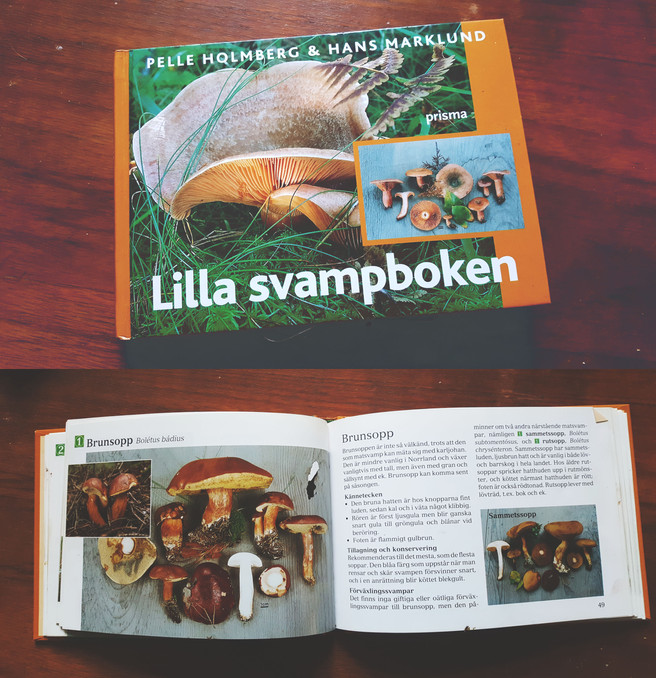
-
Gudahagen 2018
